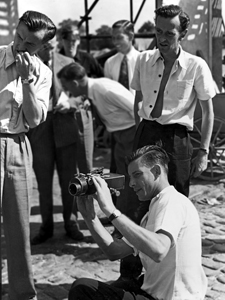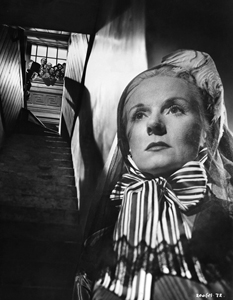Guy Green
by Marc SalomonIn the films he shot after the war, Guy Green made his mark as one of the best black and white stylists and even won an Oscar in 1947 for his work on David Lean’s Great Expectations (a historic double for British cinematographers because that same year, Jack Cardiff won the Colour Oscar for The Black Narcissus).

Born in 1913, Guy Green started work at the age of 16 on a liner, where he was in charge of maintaining the projection equipment, then he went on to join the BIP and Gainsborough as clapper-boy, progressing to camera assistant in 1933. This position allowed him to rub shoulders with cinematographers such as Gunther Kampf and Fritz Arno Wagner, before holding the camera alongside Max Greene or Ronald Neame (In Which we Serve, One of our Aircraft is Missing, This Happy Breed).
He was David Lean’s Director of Photography (between Ronald Neame then Jack Hildyard and Freddie Young) and he was responsible for the grandiose photography of two Dickens adaptations (Great Expectations and Oliver Twist) in sooty, perfectly sharp black and white, where the light/shade rapport and the high-angle and low-angle shots, as well as the depth of the shots seemed equally reminiscent of Gregg Toland’s work, of etchings and of Bill Brandt’s famous photographs, a style that was described, at the time, as neo-expressionist. Still working with Lean, he filmed the images of The Passionate Friends and Madeleine. In the latter film, Green acknowledged he had been inspired by American masters such as Lee Garmes for the aesthetics of the image and Ann Todd’s, Marlene Dietrich style photogenics.

But he was every bit as audacious working in Technicolor on Blanche Fury, made in London by Marc Allégret (Geoffrey Unsworth was responsible for the outdoor photography) and on Captain Horatio Hornblower by Raoul Walsh, “undoubtedly the most sumptuous seafaring adventure film since the war”, wrote Jacques Lourcelles. Green continued making colour movies : Ken Annakin’s Robin Hood and His Merrie Men, Peter Brook’s Beggars’ Opera, Hugo Fregonese’s Decameron Nights and Henry Levin’s The Dark Avenger, before moving on to directing. He made a score of films between 1955 and 1977, before working for television until 1986.
In 1949, he was one of the founders of the BSC along with Georges Périnal, Jack Cardiff and Freddie Young and he presided over the society from 1952 to 1954.
Special thanks to Frances Russell at the BSC, who quickly found us images of Guy Green’s work.
(Translated from French by Moira Tulloch)
 En
En Fr
Fr




